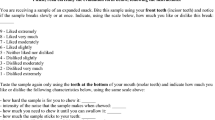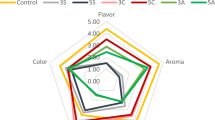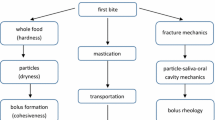Abstract
Background
Increasing viscosity can reduce the risk of aspiration into the airway, but excessively thickened food may require more force and effort. We assumed that semi-solid foods with similar viscosities will behave differently in the oropharynx and there might exist the possibility that properties other than viscosity may have clinical relevance. This study aimed to find out the texture of semi-solid foods that affects the effort of pharyngeal swallow in the older adults.
Methods
Nine kinds of semi-solid foods not requiring mastication were selected for texture profile analysis (TPA), and included whipped cream, mayonnaise, soft tofu, mango pudding, boiled mashed pumpkin, boiled mashed potatoes, boiled mashed sweet potatoes, red bean paste, and peanut butter. Hardness, adhesiveness and cohesiveness of each food were measured three times by using the rheometer. A blinded sensory test using a 9-point hedonic scale was also conducted in eighteen older adults people to investigate how much effort was required to swallow food, and how much of the food remained in the pharynx after swallowing. The correlation between texture and sensory outcome was statistically analyzed.
Results
Foods that belonged to the same viscosity category showed different texture values, and the participants also rated different scores respectively. Only adhesiveness among three properties was significantly correlated with the sensory test. (r = 0.882, p = 0.002 for difficult to swallow, r = 0.879, p = 0.002 for sense of residue).
Conclusions
Adhesiveness was the most important property of the semi-solid foods, requiring most efforts in pharyngeal swallow in the older adults. If we select and provide food having low adhesiveness value in the same viscosity category, there might be the possibility to make it easier to swallow in older adults.
Similar content being viewed by others
Background
Oropharyngeal dysphagia refers to having difficulty in transporting food safely from the mouth to the esophagus. It can cause dehydration, nutrition deficit, aspiration pneumonia and even death [1, 2]. It commonly occurs in patients with neurologic deterioration such as stroke or Parkinson disease [3] or head and neck cancers [4]. Because the incidence of dysphagia-related diseases increases with age, dysphagia occurs more frequently in the older adults [5].
Clinically, the use of viscosity-modified food has become very important in the treatment of dysphagia [6,7,8]. It is widely known that the liquid like water flows quickly and can pose a risk to people with dysphagia [6, 9]. Therefore, thickened liquids are highly recommended as slowing down the flow rate can provide the time required to close the airways [6, 10]. In contrary, excessively thickened food may require much more force on the tongue and pharynx during swallowing. People with weakened tongue and pharyngeal muscles are at risk of leaving residues in the pharyngeal recess after swallowing [11, 12].
However, we have experienced the effect of semi-solid foods with similar viscosity on swallowing is not the same. Mostly, it requires a lot of effort, but sometimes it is easy and safe for example, peanut butter vs. soft tofu. Which factors make this difference? We assumed that food texture (hardness, adhesiveness or cohesiveness), other than viscosity, might have clinical relevance. Hardness is the force that is required to compress food between the tongue and palate to a given deformation or to penetration. Adhesiveness is defined that the work required to remove food that adheres to the mouth (generally the palate) during the normal swallowing process and cohesiveness means the strength of internal bonds making up the body of the food [13]. It was especially thought to affect older adults or dysphagia patients than healthy adults. Therefore, this study was aimed to find out the texture of semi-solid food affects the effort of pharyngeal swallow in the older adults.
Methods
Test foods selection
Nine kinds of semi-solid foods with similar viscosities (fork test [14] grade 1, IDDSI [15] level 4 category and British Dietetic Association [16] Texture C) not requiring mastication were chosen for this experiment. They included whipped cream, mayonnaise, soft tofu, mango pudding, boiled mashed pumpkin, boiled mashed potatoes, boiled mashed sweet potatoes, red bean paste, and peanut butter. They were all commercially available at the market as finished products.
Texture profile analysis (TPA)
We measured the hardness, adhesiveness and cohesiveness of each food three times immediately before performing sensory tests by using a CT3 texture analyzer (AMETEK Brookfield, MA, USA) (central temperature 20 ± 0.2 °C, stain 70%, probe diameter 20 mm, infiltration meter 10.5 mm, test speed 10 mm/s). The texture profile parameters (Fig. 1) were determined as follows: (1) hardness was defined as the maximum force required for compressing foods and was calculated as the peak force of the first compression (P1) (2) adhesiveness was calculated as the negative area (B1) for the first bite, representing the work necessary to pull the compressing plunger away from the sample (3) cohesiveness was calculated as A2/A1 (A1 and A2 represent the integrated energy required for the first and second compression, respectively).
Sensory test
Subjects
Eighteen healthy older volunteers (two males and sixteen females), with an average age of 72.5 ± 6.9 years (range, 65–83), were recruited from the community through poster advertisements. They did not have any history of stroke or other brain dysfunction, head and neck cancer or anatomic alterations in that area, speech or swallowing difficulties. Additionally, they were not taking any medication that could affect their swallowing function. This study was approved by the University Hospital Institutional Review Board and informed consent was obtained from every participant.
Test procedure
All participants were invited to the test room next to the TPA room and received a 10 min educational presentation of the sensory test before they participated in the experiments. Immediately after TPA, foods were provided in a random order and blinded manner, and they were asked to swallow 5 g of each test food at once without mastication. They rated each score about; 1) how much effort was required to swallow food, and 2) how much of the food remained in the pharynx after swallowing using a 9-point hedonic scale (1 = very less, 9 = very much).
Statistical analysis
Statistical analyses were performed by using SPSS version 12.0 (SPSS, Inc., Chicago, IL, USA). The average value of hardness, adhesiveness and cohesiveness of each test food was obtained. Moreover, the average score of 18 older adults for two sensory tests was calculated. The Pearson correlation coefficient was used to evaluate the correlation between TPA and the sensory tests. The significance level was set at p < 0.05.
Results
The average values of hardness, adhesiveness and cohesiveness for each food were as shown in Table 1. Foods that belonged to the same viscosity category showed different texture values. Whipped cream had low values of hardness and adhesiveness, and red bean paste showed high values in both. Boiled mashed pumpkin, potato and sweet potato were not high in hardness but in adhesiveness. Cohesiveness did not show distinctive features between foods. The scores of sensory tests were as shown in Table 1. The participants rated different scores respectively. Whipped cream was the easiest to swallow and mango pudding had the least feeling of sticking to the throat. Peanut butter was the hardest to swallow and had greatest sticky feeling.
In the correlation test between TPA and sensory tests, only adhesiveness among three properties was significantly correlated with both sensory tests. (r = 0.882, p = 0.002 for difficult to swallow, r = 0.879, p = 0.002 for sense of residue) (Fig. 2).
Scatter plots of sensory tests (difficult to swallow and sense of residue) with hardness, adhesiveness and cohesiveness. Only adhesiveness among the three properties was significantly correlated with both sensory tests. (r = 0.882, p = 0.002 for difficult to swallow, r = 0.879, p = 0.002 for sense of residue)
Discussion
It was found that among the three texture properties, adhesiveness was associated with the sensation of swallowing difficulty in the older adults. Adhesiveness is defined as the work necessary to overcome the attractive forces between the surface of the food and that of other materials with which the food comes into contact and calculated by measuring the negative area for the first bite, representing the work necessary to pull compressing probe away from food [13]. This definition might explain why adhesiveness is related to the difficulty of swallowing and sense of residue in the older adults.
To date, studies related to dysphagia diet have been conducted in terms of viscosity, [6, 10] and accordingly, classification of dysphagia diet has been mostly based on viscosity [15, 17]. Although viscosity is important, at the highest viscosity level (solid foods), further classification is primarily related to chewing (minced, grinded or soft etc.) and less related to pharyngeal swallowing. We assumed that other texture properties besides viscosity might be associated with pharyngeal swallowing difficulties in the older adults. We also found out the relevant possibility of adhesiveness.
Only one study mentioned the relation between food texture and dysphagia [18]. They investigated the association between the texture of semi-solid foods and fiberoptic endoscopic swallowing study findings in post-stroke dysphagic patients and suggested significant relation with cohesiveness according to residue deposition and gumminess according to aspiration. However, they had limitation about the use the different viscous foods restricted to stroke dysphagic patients and there was also a lack of explanation about the reason of their relations.
Motor function related to swallowing becomes increasingly dampened with age. Age-related anatomical changes in swallowing function include a decreased cross-sectional area of masticatory muscles (masseter and medial pterygoid), increased tongue atrophy and fatty infiltration and decreased diameter of tongue muscle fiber [19]. Age-related decrease in force, mobility and endurance is also definite in the lingual and pharyngeal muscle [20, 21]. For this reason, food texture affects swallowing in older people more.
Major limitation of this study is that sensory test is not sufficient to evaluate the effect of food texture properties on the swallowing performance. It might be a bit controversial to compare the TPA results with the sensorial test performed which is based on subjections. It would be better if more accurate functional data of swallowing physiology such as videofluoroscopic swallowing study were added. We have tried to reduce the likelihood of confounding factors. We only used foods that were commercially available at the market as finished products. We performed sensory tests immediately after the TPA test. Food was provided in a random and blinded order, and the participants swallowed food without chewing. Nevertheless, the problems of food homogeneity, mixing with saliva and temperature changes can make another limitation of this study.
Conclusions
Adhesiveness was the most important property of semi-solid food requiring most efforts in pharyngeal swallow in the older adults. If we select and provide the food having low adhesiveness value in the same viscosity category, there might be a possibility to make it easier to swallow in the older adults.
Availability of data and materials
All data generated or analyzed during this study are included in this published article.
Abbreviations
- IDDSI:
-
International Dysphagia Diet Standardization Initiative
- TPA:
-
Texture profile analysis
References
Doggett DL, Tappe KA, Mitchell MD, Chapell R, Coates V, Turkelson CM. Prevention of pneumonia in elderly stroke patients by systematic diagnosis and treatment of dysphagia: an evidence-based comprehensive analysis of the literature. Dysphagia. 2001;16(4):279–95.
Ekberg O, Hamdy S, Woisard V, Wuttge-Hannig A, Ortega P. Social and psychological burden of dysphagia: its impact on diagnosis and treatment. Dysphagia. 2002;17(2):139–46.
Garcia JM, Chambers E. Managing dysphagia through diet modifications. Am J Nurs. 2010;110(11):26–33 quiz 34-25.
Pauloski BR, Rademaker AW, Logemann JA, Stein D, Beery Q, Newman L, Hanchett C, Tusant S, MacCracken E. Pretreatment swallowing function in patients with head and neck cancer. Head Neck. 2000;22(5):474–82.
Humbert IA, Robbins J. Dysphagia in the elderly. Phys Med Rehabil Clin N Am. 2008;19(4):853–66 ix-x.
Clave P, de Kraa M, Arreola V, Girvent M, Farre R, Palomera E, Serra-Prat M. The effect of bolus viscosity on swallowing function in neurogenic dysphagia. Aliment Pharmacol Ther. 2006;24(9):1385–94.
Newman R, Vilardell N, Clave P, Speyer R. Effect of bolus viscosity on the safety and efficacy of swallowing and the kinematics of the swallow response in patients with Oropharyngeal dysphagia: white paper by the European Society for Swallowing Disorders (ESSD). Dysphagia. 2016;31(2):232–49.
Rofes L, Arreola V, Mukherjee R, Swanson J, Clave P. The effects of a xanthan gum-based thickener on the swallowing function of patients with dysphagia. Aliment Pharmacol Ther. 2014;39(10):1169–79.
Logemann JA. Swallowing physiology and pathophysiology. Otolaryngol Clin N Am. 1988;21(4):613–23.
Logemann JA. Noninvasive approaches to deglutitive aspiration. Dysphagia. 1993;8(4):331–3.
Huckabee ML, Steele CM. An analysis of lingual contribution to submental surface electromyographic measures and pharyngeal pressure during effortful swallow. Arch Phys Med Rehabil. 2006;87(8):1067–72.
Steele CM, Huckabee ML. The influence of orolingual pressure on the timing of pharyngeal pressure events. Dysphagia. 2007;22(1):30–6.
Bourne MC. Food texture and viscosity : concept and measurement. 2nd ed. San Diego: Academic Press; 2002.
Park JW, Kim IJ, Lee HJ. Fork test: a new simple and reliable consistency measurement for the dysphagia diet. Geriatr Nurs. 2016;37(4):292–5.
Cichero JAY, Lam PTL, Chen J, Dantas RO, Duivestein J, Hanson B, Kayashita J, Pillay M, Riquelme LF, Steele CM, et al. Release of updated international dysphagia diet standardisation initiative framework (IDDSI 2.0). J Texture Stud. 2020;51(1):195–6.
Cichero JA, Steele C, Duivestein J, Clave P, Chen J, Kayashita J, Dantas R, Lecko C, Speyer R, Lam P, et al. The need for international terminology and definitions for texture-modified foods and thickened liquids used in dysphagia management: foundations of a global initiative. Curr Phys Med Rehabil Rep. 2013;1:280–91.
McCallum SL. The National Dysphagia Diet: implementation at a regional rehabilitation center and hospital system. J Am Diet Assoc. 2003;103(3):381–4.
Momosaki R, Abo M, Kobayashi K. Swallowing analysis for semisolid food texture in poststroke dysphagic patients. J Stroke Cerebrovasc Dis. 2013;22(3):267–70.
Bassler R. Histopathology of different types of atrophy of the human tongue. Pathol Res Pract. 1987;182(1):87–97.
Crow HC, Ship JA. Tongue strength and endurance in different aged individuals. J Gerontol A Biol Sci Med Sci. 1996;51(5):M247–50.
Ekberg O, Feinberg MJ. Altered swallowing function in elderly patients without dysphagia: radiologic findings in 56 cases. AJR Am J Roentgenol. 1991;156(6):1181–4.
Acknowledgements
None.
Funding
This research was supported by a grant (NRF-2019R1F1A1043950) of the Basic Science Research Program through the National Research Foundation of Korea (NRF) funded by the Ministry of Science and ICT, Republic of Korea. The funder had no role in the design of the study and collection, analysis, and interpretation of data and in writing the manuscript.
Author information
Authors and Affiliations
Contributions
SL, KN and BY performed the research and collected all data. JP designed the research, performed data analysis and wrote the paper. All authors have read and approved the manuscript.
Corresponding author
Ethics declarations
Ethics approval and consent to participate
This study was approved by Dongguk University Ilsan Hospital Institutional Review Board (Approval No. 2019–07–010-002) and written informed consent was obtained from all individual participants included in the study.
Consent for publication
Not applicable.
Competing interests
All authors state no conflict of interest.
Additional information
Publisher’s Note
Springer Nature remains neutral with regard to jurisdictional claims in published maps and institutional affiliations.
Supplementary Information
Rights and permissions
Open Access This article is licensed under a Creative Commons Attribution 4.0 International License, which permits use, sharing, adaptation, distribution and reproduction in any medium or format, as long as you give appropriate credit to the original author(s) and the source, provide a link to the Creative Commons licence, and indicate if changes were made. The images or other third party material in this article are included in the article's Creative Commons licence, unless indicated otherwise in a credit line to the material. If material is not included in the article's Creative Commons licence and your intended use is not permitted by statutory regulation or exceeds the permitted use, you will need to obtain permission directly from the copyright holder. To view a copy of this licence, visit http://creativecommons.org/licenses/by/4.0/. The Creative Commons Public Domain Dedication waiver (http://creativecommons.org/publicdomain/zero/1.0/) applies to the data made available in this article, unless otherwise stated in a credit line to the data.
About this article
Cite this article
Park, JW., Lee, S., Yoo, B. et al. Effects of texture properties of semi-solid food on the sensory test for pharyngeal swallowing effort in the older adults. BMC Geriatr 20, 493 (2020). https://doi.org/10.1186/s12877-020-01890-4
Received:
Accepted:
Published:
DOI: https://doi.org/10.1186/s12877-020-01890-4






